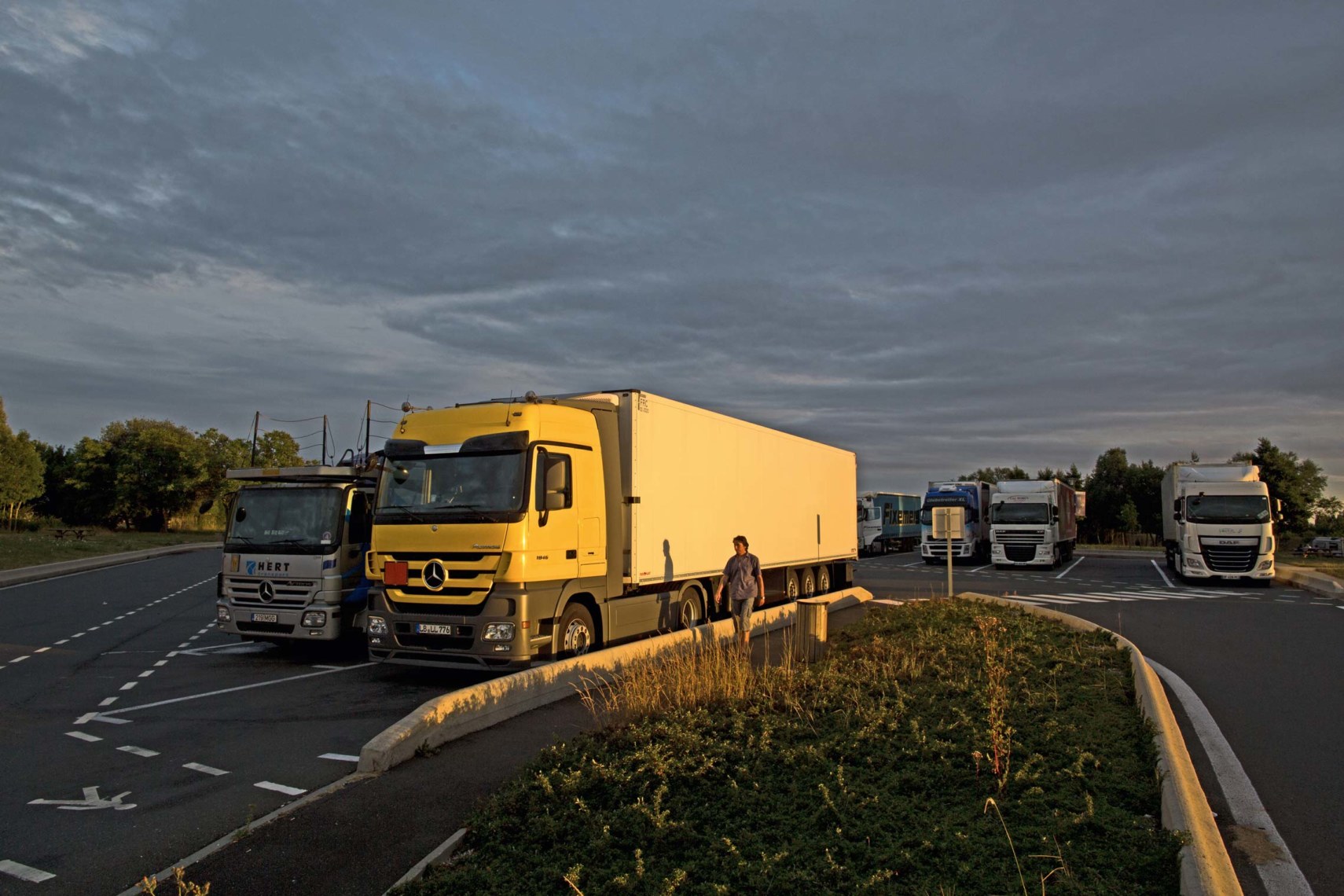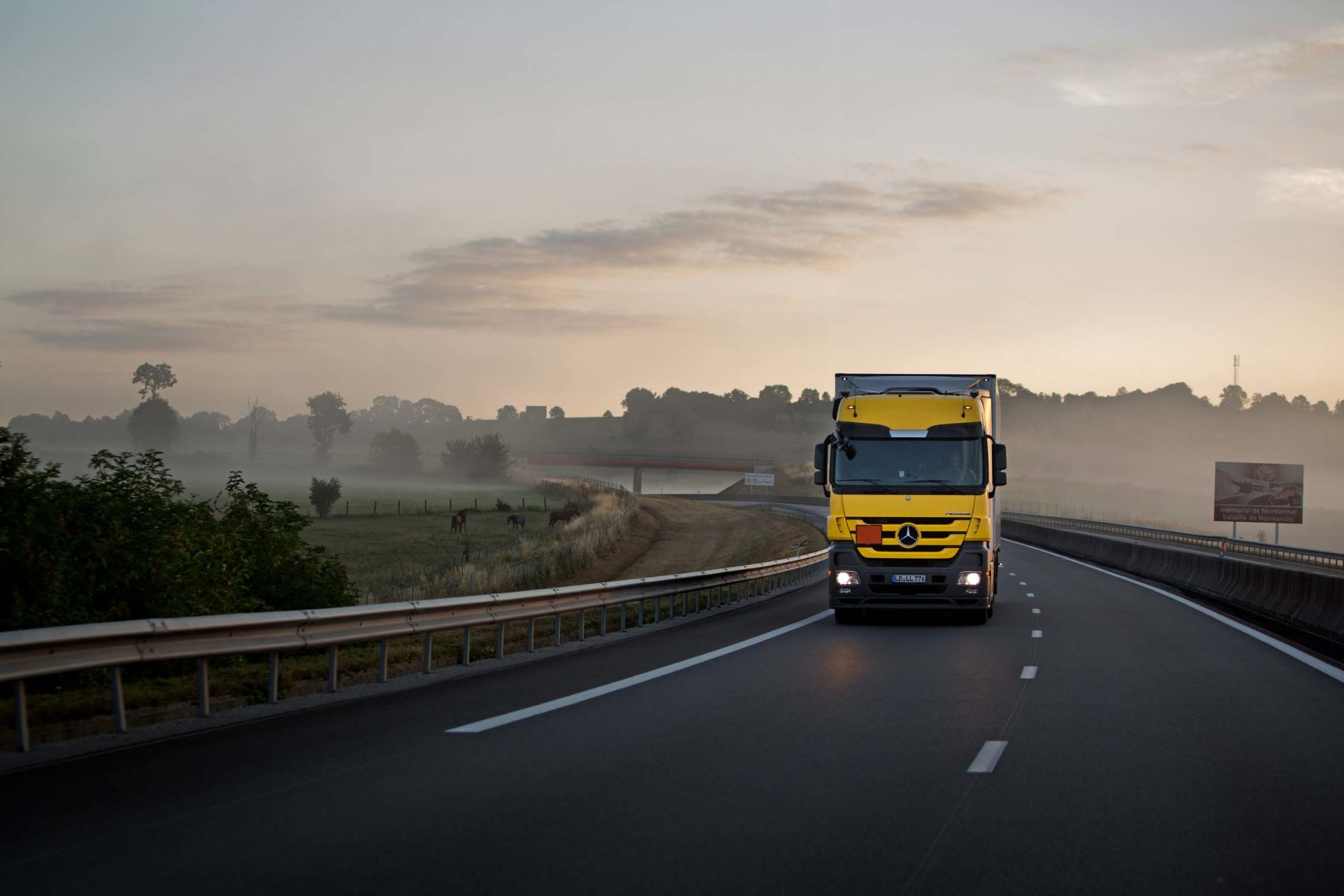“If I sound the two horns on the roof, you’d think a ship was entering the harbor”, Waldemar Nesner.
One man, his truck and the road
The tattoos on his right forearm date back to his time in the navy. Two gold earrings twinkle in his left ear. He traveled the world as a young man. Today, he finds nothing more enjoyable than to drive a 40-ton truck along the highway, to step on the gas and “hear the engine at work.” It is a 460-hp engine. The maximum load is 24 tons. It takes several minutes before reaching the maximum permitted speed of 80 kilometers (50 miles) an hour when there is a heavy load on board.
Nesner switches to cruise control and lets it roll—one man, his truck and the road. “If I sound the two horns on the roof, you’d think a ship was entering the harbor,” he grins.
His weekly Tour de France is nearly twelve hundred forty-five miles long. And he always drives it in his yellow truck. The cab paint of his Mercedes Actros reflects the first rays of sunlight that appear on the horizon. Yesterday he already delivered to four customers. Today four more are on the list. Most of the time it is wet paint, sometimes powder coating. Wörwag sent almost 1,400 tons to France last year. 230 of them were driven by Nesner.

Delivery service: In France, up to nine Wörwag customers await new goods every week.
Nesner knows every inch of road
Next station: Vire, a town in the region of Lower Normandy. When planning a route, Nesner sticks to the suggestion given by his navigation system, which not only takes into account overhead clearance, but also restrictions for the transport of dangerous goods. Some roads are therefore off-limits, including many country roads and narrow towns.
In the meantime, Nesner rarely needs the GPS. He knows every kilometer of the road. The route goes to Vire via Alençon and Flers. The D 962 country road is hilly, and keeps passing fields of crops and the typical Norman stone houses with their picturesque façades. The next destination is located in a small industrial park. Nesner knows the logistics man there, and it is a quick stop. Ten minutes later, both pallets of liquid paint are unloaded and the journey continues.
“Usually I am planning the weekend. This Saturday, for example, I’m going to assemble the awning for my trailer”, says Nenner.

The tattoos on his right forearm date back to his time in the navy.
172 kilometer (107 miles) to the Bolleville rest stop
The many miles of road offer plenty of time for reflection. “Usually I am planning the weekend. This Saturday, for example, I’m going to assemble the awning for my trailer.” Then he turns on the radio. At the steering wheel he likes to listen to chansons, he says with a laugh. “It’s not really my music,” admits the man who somewhat resembles and is a fan of actor Tommy Lee Jones. At home, Deep Purple, AC/DC, Iron Maiden and Motörhead albums occupy his shelves. A particular treasure is the original double album of the British rock band Led Zeppelin that went with the concert film The Song Remains the Same.
“I don’t do any cooking, otherwise I would have to do dishes afterwards,” laughs Nesner.
After two hours on the A84, A13 and A29 through the Calvados metropolis Caen and across the impressive Pont de Normandie, Nesner reaches the Bolleville rest area. After four and a half hours at the wheel, he is required to take a 45 minute rest. After that he can drive an equal period which adds up to a nine-hour shift. Nesner is looking forward to a shower.
He keeps all the food supplies he needs for a week in the refrigerated storage compartment. Spartan but tasty: farmers bratwurst, tzatziki, palatine liverwurst and pickles. Sometimes he buys a fresh loaf of French bread. But usually he has enough brown country bread from his home in Bad Urach, just under an hour’s drive from Stuttgart. “I don’t do any cooking, otherwise I would have to do dishes afterwards,” laughs Nesner.
The cold storage compartment also has room for his evening beer. But that will have to wait. After forty-five minutes he is on the road again taking the A29 towards Abbeville. Final sprint. The last customers receive their products—on time! In ten years, the only long delays were due to a two-day driving ban caused by a snow storm and a road blockade by French farmers.
Only a few kilometers are left before he will have to stop driving. At the rest stop in St. Quentin, Nesner scans the parking lot with a trained eye for a spot where his truck will be at a slight angle—to elevate the head of the bed slightly. If that is not possible, he keeps a four-inch high wooden wedge with him. The seven-zone cold foam mattress behind the seat measures 250 times 70 centimeters (three by eight feet). It is where Nesner can decompress. At 6 p.m. he calls his wife Monika. They phone for at least half an hour. They have come to terms with his multi-day tours around Europe. In November, they’ll celebrate their silver wedding anniversary.

Slowing down: Leisure time after the end of the shift is spent in the parking lot.
Slowly the parking area fills up with other trucks.
Contact to other truckers is rather rare. Their paths cross, but in this case the path is not the goal. Nesner draws the curtains early and turns on the laptop, he pops in a DVD, and watches another episode of the television series Vikings. A welcome distraction as the days on the road don’t provide much variety. Towards 10 p.m. the truck lights go off. Seven hours to go until Jump start.
Bigger payload thanks to SMC
The daughter of the transport operator Jörg Schäfauer chose the colour for the paint of Nesner’s cab. Wörwag’s bright Mercedes-yellow is integral to the image of the freight-forwarding company from Bietigheim-Bissingen. The plastic body parts are not only eye-catching, but also light. The shipper can add the weight saved to the payload.
The secret is a composite material called Sheet Molding Compound (SMC), which is only about one-third of the weight of steel. SMC is composed of a thermosetting reaction resin and glass fibers. It is delivered in sheet form. In the production of SMC parts, air pockets sometimes arise, which may later outgas and damage the paint surface. To prevent this, Wörwag has developed a special primer coat called barrier primer W321. It forms a solid layer that significantly reduces outgassing from the material.

Wolfgang Fritz,
at Wörwag since 1997. As Head of Customer Labs, the trained paint lab assistant oversees the coatings for plastic add-on parts for commercial vehicles. “Lightweight designs are in surprising demand for trucks. Cutting weight reduces fuel consumption and increases the payload. This also saves trips.”
Text: Michael Thiem
Photos: Toby Binder, Frederik Laux



